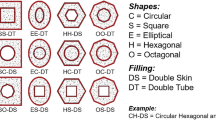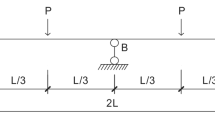Abstract
This paper addresses the heat transfer evaluation problem in RC members at standard fire loads. Accidental fire events in building structures are common, in which structural RC members come often into contact with severe fire conditions that directly affect their stability and integrity against collapse. The code and standard practices do not provide any provisions for fire resistance rating evaluation and specify the fire resistance rating of RC members by acknowledging their applicability in terms of concrete cover provision. RC member failure appraisal in performance-based design and analysis is one of the significant concerns in the recent era which depends on appropriate heat transfer analysis. In transient heating boundary conditions with associated influencing material properties, i.e., thermal conductivity, specific heat carry capacity, and diffusivity for normal strength concrete (NSC) and high strength concrete (HSC) are completely different, which directly influence heat transfer behavior using heating mechanisms. Therefore, a finite difference method (FDM) based heat transfer evaluation method has been proposed for both NSC and HSC with consideration of thermally induced material properties and appropriate heating mechanisms. The proposed method prediction has been verified with the experimentally performed database and it is observed suitable to evaluate heat transfer in RC members made by NSC and HSC at exposure to the standard fire load.
Access this chapter
Tax calculation will be finalised at checkout
Purchases are for personal use only
Similar content being viewed by others
Abbreviations
- α:
-
Thermal diffusivity [mm/s]
- ε:
-
Emissivity
- Δx = Δy:
-
Size of elements [mm]
- μ:
-
Moisture content [%]
- θ:
-
Heat transfer coefficient
- τ:
-
Stability equation of heat tranfere model [kg/m3]
- σ:
-
Stefan-Boltzmann constant [W/m2K4]
- Cp:
-
Specific heat [J/kgK]
- hc:
-
Convective heat transfer coefficient [W/m2K]
- k:
-
Thermal conductivity [W/mK]
- Tm,np:
-
Temperature in element [°C]
References
Gedam BA (2021) Fire resistance design method for reinforced concrete beams to evaluate fire-resistance rating. Structures 33:855–877
EN 1992-1-2, Eurocode 2 (2004), Design of concrete structures—Part 1–2: General rules—Structural fire design., Commission of European Communities, Brussels
NBC (2016) National building code of India, vol 1. Bureau of Indian Standards, New Delhi, India
IS 456 (2000) Plain and reinforced concrete – code of practice. Bureau of Indian Standards, 1–100
IS 1642, 1989, Code of practice for fire safety of buildings (general) – Details of construction.”, Bureau of India Standards, New Delhi.
IS 3809, Fire resistance test for structures. Bureau of Indian Standards, 1979, 1–14.
ISO 834, Fire resistance test element – Elements of building construction – Part 1: General requirements, 1999, 1–25.
BS 476–22, 1978, Fire test on building materials and structures, Methods for determination of the fire resistance of load bearing elements of construction.
ASTM E119, Standard test method for fire tests of building construction and materials, ASTM International, 2016, pp. 1–36.
Kodur et al (2010) Energy based time equivalent approach for evaluating fire resistance of reinforced concrete beams. Fire Saf J 45(4):211–220
Gao et al (2013) Finite element modeling of reinforced concrete beams exposed to fire. Eng Struct 52:488–501
Gao et al (2017) Fire resistance of RC beams under design fire exposure. Mag Concr Res 69(8):402–423
Kumar P, Kodur VKR (2017) Modeling the behavior of load bearing concrete walls under fire exposure. Constr Build Mater 154:993–1003
U. Wickstrom, A very simple method for estimating temperatures in fire exposed structures, New Technology to Reduce Fire Losses and Costs. Ed., Grayson. S. J. and Smith, D.A., Elsevier Applied Science, London, UK, 1986, pp. 186–194.
Lie TT, Irwin RJ (1993) Method to calculate the fire resistance of reinforced concrete columns with rectangular cross section. ACI Struct J 90(1):52–60
Desai SB (1998) Design of reinforced concrete beams under fire exposure conditions. Mag Concr Res 50(1):75–83
Abbasi A, Hogg PJ (2005) A model for predicting the properties of the constituents of a glass fibre rebar reinforced concrete beam at elevated temperatures simulating a fire test. Compos B Eng 36(5):384–393
Kodur V, Baolin Y, Dwaikar M (2013) A simplified approach for predicting temperature in reinforced concrete members exposed to standard fire. Fire Saf J 56:39–51
Gao WY, Dai JG, Teng JG (2014) Simple method for predicting temperatures in reinforced concrete beams exposed to a standard fire. Adv Struct Eng 17(4):573–589
Kodur VR, Sultan MA (2003) Effect of temperature on thermal properties of high-strength concrete. J Mater Civ Eng 15(2):101–107
Gedam BA, Bhandari NM, Upadhyay A (2016) Influence of supplementary cementitious materials on shrinkage, creep, and durability of high-performance concrete. J Mater Civ Eng 28(4):04015173
Gedam BA (2019) Time-dependent behaviour prediction of the prestressed HPC I-girder. Eng Struct 201:109763
Ngo et al (2013) Testing of normal- and high-strength concrete walls subjected to both standard and hydrocarbon fires. ACI Struct J 110(3):1–8
Kodur VKR, Cheng FP, Wang TC, Sultan MA (2003) Effect of strength and fiber reinforcement on fire resistance of high-strength concrete columns. J Struct Eng 129(2):253–259
Acknowledgements
The author wishes to express their gratitude and sincere appreciation to the authority of the Council of Scientific and Industrial Research (CSIR), India in Project No. MLP072002 for financing this research work. Also, for several ongoing research projects associated with the FBR in Civil Infrastructure and Engineering during his service period in Fire Safety Engineering, CSIR—Central Building Research Institute, Roorkee.
Author information
Authors and Affiliations
Corresponding author
Editor information
Editors and Affiliations
Rights and permissions
Copyright information
© 2024 The Author(s), under exclusive license to Springer Nature Singapore Pte Ltd.
About this paper
Cite this paper
Gedam, B.A. (2024). Heat Transfer Evaluation Method for RC Members at Standard Fire Scenario. In: Singh, K.M., Dutta, S., Subudhi, S., Singh, N.K. (eds) Fluid Mechanics and Fluid Power, Volume 1. FMFP 2022. Lecture Notes in Mechanical Engineering. Springer, Singapore. https://doi.org/10.1007/978-981-99-7827-4_22
Download citation
DOI: https://doi.org/10.1007/978-981-99-7827-4_22
Published:
Publisher Name: Springer, Singapore
Print ISBN: 978-981-99-7826-7
Online ISBN: 978-981-99-7827-4
eBook Packages: EngineeringEngineering (R0)




